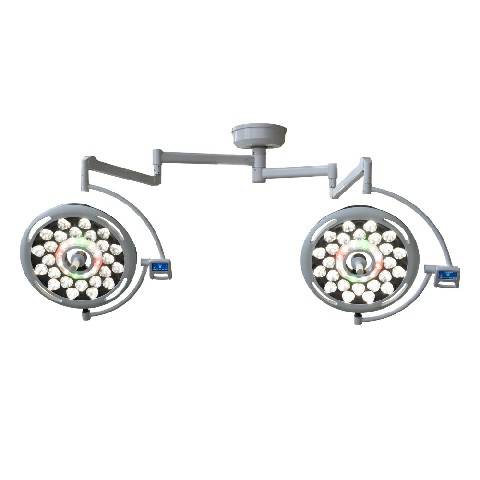Die Anschrift
304 Nordkardinal St.
Dorchester Center, MA 02124
Arbeitsstunden
Montag bis Freitag: 7:00 - 19:00
Wochenende: 10:00 - 17:00
Operationsleuchten, auch Operationsleuchten oder OP-Leuchten genannt, sind wichtige medizinische Geräte, die zur Beleuchtung des Operationsfeldes in Operationssälen und anderen medizinischen Einrichtungen eingesetzt werden. Da Gesundheitseinrichtungen veraltete Geräte modernisieren oder neue Operationssäle einrichten möchten, stellen OP-Leuchten große Kapitalinvestitionen dar. Dieser Blogbeitrag dient als Leitfaden für medizinische Einrichtungen und Personal, die neue oder Ersatz-OP-Leuchten kaufen möchten.
Wir gehen auf die wichtigsten Aspekte ein, die Sie bei der Auswahl der für Ihre Einrichtung zum Verkauf stehenden Operationsleuchten berücksichtigen sollten, darunter:
Wir beantworten außerdem häufig gestellte Fragen zum Kauf von OP-Leuchten. Lesen Sie weiter, um einen umfassenden Überblick über den Markt für OP-Leuchten zu erhalten und Ihre Kaufentscheidung zu erleichtern.

Beim Vergleich von OP-Leuchten verschiedener Hersteller sind verschiedene wichtige Merkmale und Spezifikationen zu berücksichtigen. Diese Parameter können die Beleuchtungsleistung, Funktionalität und Benutzerfreundlichkeit der Leuchten erheblich beeinflussen. Zu den wichtigsten Faktoren gehören:
Beleuchtungsstärke oder Lichtintensität
Die Helligkeit des Lichts wird in Lux oder Footcandle gemessen. Die meisten Operationsleuchten bieten eine Helligkeit zwischen 60.000 und 160.000 Lux. Eine höhere Intensität ermöglicht eine bessere Visualisierung.
Farbwiedergabeindex (CRI)
Ein Maß für die Genauigkeit der Farbwiedergabe. CRIs von 90+ ähneln natürlichem Sonnenlicht.
Farbtemperatur
Die Wärme oder Kälte des Lichts, gemessen in Kelvin (K). Farbtemperaturen von 3.500–5.000 K eignen sich am besten für Operationen.
Feldgröße und Schärfentiefe
Die Größe und Tiefe des beleuchteten Operationsbereichs. Je größer, desto flexibler.
Punktgröße
Der Durchmesser des Fokuspunkts bei einem festgelegten Arbeitsabstand. Kleinere Punkte konzentrieren die Beleuchtung.
Schattenreduzierung
Wie gut das Licht Schatten im Operationsfeld minimiert. Wichtig zur Verringerung der Augenbelastung.
Kopfgröße und -positionierung
Die Positionierungsmöglichkeiten und die Größe des Leuchtenkopfes beeinflussen die Flexibilität. Größere Köpfe mit flexiblen Armen sind am anpassungsfähigsten.









Operationsleuchten nutzen verschiedene Technologien, um eine helle, schattenfreie und gleichmäßige Beleuchtung des Operationsfeldes zu gewährleisten. Die Vor- und Nachteile der einzelnen Technologien zu kennen, ist für den Vergleich hilfreich. Die meisten Operationsleuchten verwenden entweder Halogen-, LED- oder Xenon-Lampen.
Vergleich chirurgischer Lichttechnologien
| Technologie | Pro | Nachteile |
|---|---|---|
| Halogen | Vertraute Technologie Vollspektrumlicht | Hohe Wärmeentwicklung Glühbirnen müssen häufig ausgetauscht werden |
| LED | Lange Lebensdauer der Glühbirne Energieeffizient Sofortiges Ein-/Ausschalten | Höhere Vorlaufkosten Eingeschränktes Spektrum |
| Xenon | Höhere Intensität Vollspektrumlicht Sofortiges Ein-/Ausschalten | Teure Glühbirnen Glühbirnen müssen ausgetauscht werden |
Wie aus der Tabelle hervorgeht, hat sich die LED-OP-Beleuchtung dank erheblicher Fortschritte bei der Erhöhung der Intensität, der Verbesserung der Farbqualität und der Senkung der Technologiekosten als die dominierende Wahl etabliert. Die meisten großen Medizintechnikunternehmen konzentrieren ihre Forschungs- und Entwicklungsaktivitäten sowie ihre Produktion mittlerweile auf LED-OP-Beleuchtung.
Es gibt eine große Auswahl an Marken und Herstellern von OP-Beleuchtung mit unterschiedlichen Produktlinien, Preisen und Technologien. Zu den wichtigsten Anbietern im Bereich der OP-Beleuchtung gehören:
Diese Liste kratzt nur an der Oberfläche der Dutzenden von Unternehmen, die chirurgische Beleuchtungslösungen anbieten. Es ist ratsam, Fallstudien, Erfahrungsberichte und Produktbewertungen für jede in Frage kommende Marke auszuwerten.
Der Preis ist zwangsläufig ein wichtiger Faktor bei der Investition in medizinische Geräte wie Operationsleuchten. Die Kosten variieren stark, abhängig von:
Halogenlampen der Einstiegsklasse laufen $5,000 – $15,000. Mittelklasse-LEDs kosten $25,000 – $75,000. Top-of-the-Line-Plattformen mit maximaler Flexibilität und Konnektivität können kosten $100,000+. Für die strukturelle Verstärkung von Decken/Auslegern, Installationsleistungen, Schulungen und mehrjährige Wartungsverträge, die bei Operationsleuchten üblich sind, können zusätzliche Kosten anfallen.
Bei der Budgetierung für neue Operationsleuchten sollten medizinische Einrichtungen Folgendes berücksichtigen:
Um den ROI von Investitionen in Operationsbeleuchtung zu prognostizieren und den Wert zu maximieren, ist es von entscheidender Bedeutung, die gesamten Lebenszykluskosten zu verstehen.

Um Leistung und Lebensdauer zu gewährleisten, erfordern OP-Leuchten eine fachgerechte Installation, regelmäßige Wartung und Garantieleistungen. Seriöse Hersteller bieten mehrjährige Garantien auf Teile und Arbeitsleistung sowie Servicegarantien. Standardmäßig enthalten:
Unsachgemäße Wartung der Leuchten führt jedoch zu reduzierter Leistung, Farbverschiebungen, vermehrten Schatten und Lampen- oder Komponentenausfällen deutlich vor der erwarteten Lebensdauer. Die Einhaltung der vom Hersteller empfohlenen Wartungspläne ist ebenso wichtig wie die Verlängerung von Serviceverträgen nach Ablauf der ursprünglichen Garantiezeit.
Die Anschaffung neuer OP-Leuchten ist eine komplexe Entscheidung mit hohem Risiko für die Patientensicherheit und den Operationserfolg. Wichtige Hinweise bei der Auswahl geeigneter Lösungen:
Darüber hinaus bieten viele Anbieter Demogeräte an, mit denen Chirurgen und Personal Alternativen in simulierten OP-Umgebungen testen können. Mithilfe dieser Demos können Sie direkt überprüfen, ob die Leuchten den individuellen Anforderungen Ihrer Einrichtung entsprechen.
Durch sorgfältige Recherche der verfügbaren Optionen auf dem wachsenden Markt für Operationsleuchten können medizinische Einrichtungen wertvolle Investitionen tätigen, die die chirurgische Visualisierung verbessern und die Behandlungsergebnisse langfristig verbessern. Bei weiteren Fragen wenden Sie sich während Ihres Kaufprozesses an uns!
Welche Hauptfaktoren müssen bei der Betrachtung chirurgischer Beleuchtung?
Die entscheidenden Faktoren sind: Lichtintensität/Beleuchtungsstärke, Farbwiedergabegenauigkeit, Feldgröße und Schärfentiefe, Schattenreduzierung, Flexibilität und Positionierung, Größe/Gewicht, Lebensdauer und Austauschbedarf der Glühbirne, angebotene Technologien, Garantiebedingungen, verfügbare Wartungsverträge und natürlich die Kosten.
Was ist besser – Halogen-, LED- oder Xenon-OP-Leuchten?
LED-OP-Leuchten bieten heute meist die beste Balance zwischen Helligkeit, Effizienz, Lebensdauer und minimaler Schattenbildung. Achten Sie jedoch darauf, dass jedes in Frage kommende LED-System eine hohe Farbwiedergabe aufweist, da frühere LEDs mit der Farbwiedergabe zu kämpfen hatten.
Wie lange halten OP-Leuchten?
Bei ordnungsgemäßer Installation, regelmäßiger vorbeugender Wartung und Teileaustausch nach Bedarf beträgt die durchschnittliche Lebensdauer zwischen 8 Jahren bei Halogenlampen und über 12 Jahren bei hochwertigen LED-OP-Beleuchtungssystemen.
Ist es günstiger, generalüberholte/gebrauchte Operationsleuchten zu kaufen?
Mitunter lassen sich durch den Kauf generalüberholter Geräte erhebliche Kosten sparen. Um die verbleibende Nutzungsdauer zu ermitteln, sollten jedoch die genauen Betriebsstunden bestätigt und die aktuelle Lichtintensität gemessen werden. Für generalüberholte Geräte sollten außerdem erweiterte Wartungsverträge abgeschlossen werden. Stellen Sie sicher, dass gebrauchte Leuchten auch weiterhin den aktuellen Sicherheitsstandards entsprechen.
Sollten Sie Operationsleuchten von derselben Marke kaufen wie die übrige OP-Ausrüstung?
Im Idealfall ja – die Abstimmung der OP-Beleuchtung auf bestehende OP-Gerätemarken ermöglicht bessere Interoperabilität, Konnektivität und einheitliche Datenintegration. Allerdings ist es immer noch üblich, Beleuchtungseinheiten verschiedener Hersteller zu kombinieren, wenn ein Markenwechsel die Technologie deutlich verbessert oder die Kosten erhöht. Achten Sie jedoch darauf, dass die bevorzugten Hersteller die Kompatibilität gewährleisten.
